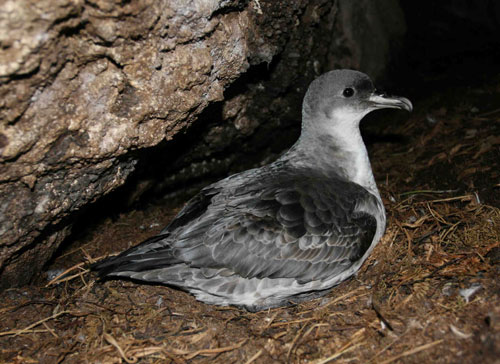South Africa's Antarctic supply ship, the m.v. S.A. Agulhas, sets sail today from Cape Town on its last voyage before replacement to Marion Island in the southern Indian Ocean to undertake the annual relief of the weather station.
Aboard will be a team of marine ornithologists led by Peter Ryan (FitzPatrick Institute, University of Cape Town) who will initiate a three-year project to study the current status of the island's suite of burrowing petrels, two decades after feral cats Felis silvestris catus were finally eradicated in 1991 following a long campaign. The cats at their peak were devastating the island's burrowing seabirds, killing approaching half a million a year.
Two of the island's burrowing seabird species are ACAP-listed: the White-chinned Procellaria aequinoctialis and Grey P. cinerea Petrels, but the new study also aims to look at the distribution and numbers of the smaller gadfly petrels Pterodroma spp., Blue Petrels Halobaena caerulea and prions Pachyptila spp. to see what changes have occurred since the last detailed investigations were conducted on them in the early 1980s.
Two small studies around the time of the cat eradication did show improved breeding success for several species of Marion's burrowing petrels, but little is known about any changes in their population sizes since then. Spotlighting observations do suggest that some storm petrels have increased in abundance and one of two diving petrels Pelecanoides spp. has recently been found breeding after a long gap.
However, data from Subantarctic Skuas Stercorarius antarctica lonnbergi are not encouraging. The numbers of skuas breeding on Marion Island have halved over the last two decades, and the proportion of burrowing petrels in their diet has increased only marginally, despite a 30% decrease in numbers of penguins, their other main prey. Burrowing petrels make up less than half of skua diets on Marion Island, compared to more than 90% on adjacent Prince Edward Island - which has always been free of introduced mammals.
Mike Schramm, who estimated densities of burrowing petrels on Marion Island in the late 1970s for his MSc, will return to the island with the annual relief for the first time in more than 30 years. It will be fascinating to learn his perceptions of how the island has changed over this period, which has seen the demise of the cats and significant changes to the island's vegetation.
I will also be aboard the ship and intend to post further reports from the island to ACAP Latest News during the course of the month.

Incubating Grey Petrel on Marion Island. Photograph by Peter Ryan
With thanks to Peter Ryan for information.
Selected References:
Bester, M.N., Bloomer, J.P., van Aarde, R.J., Erasmus, B.H., van Rensburg, P.J.J., Skinner, J.D., Howell, P.G. & Naude, T.W. 2002. A review of the successful eradication of feral cats from sub-Antarctic Marion Island, southern Indian Ocean. South African Journal of Wildlife Research 31: 65-73.
Cooper, J. & Fourie, A. 1991. Improved breeding success of Great-winged Petrels Pterodroma macroptera following control of feral cats Felis catus at subantarctic Marion Island. Bird Conservation International 1: 171-175.
Cooper, J. Marais, A.V.N., Bloomer, J.P. & Bester, M.N. 1995. A success story: breeding of burrowing petrels (Procellariidae) before and after eradication of feral cats Felis catus at sub-Antarctic Marion Island. Marine Ornithology 23: 33-37.
McClelland, G.T.W., Cooper, J. & Chown, S.L. in press. First proof of breeding by South Georgia Diving Petrel Pelecanoides georgicus following feral cat Felis catus eradication at sub-Antarctic Marion Island. Marine Ornithology.
Schramm, M. 1986. Burrow densities and nest site preferences of petrels (Procellariidae) at the Prince Edward Islands. Polar Biology 6: 63-70.
John Cooper, ACAP Information Officer, 12 April 2012

 English
English  Français
Français  Español
Español